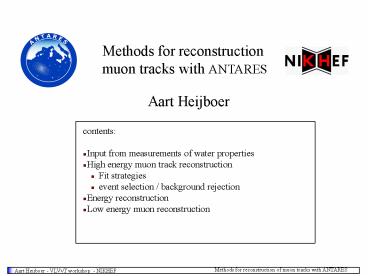Methods for reconstruction PowerPoint PPT Presentation
Title: Methods for reconstruction
1
Methods for reconstruction muon tracks with
ANTARES
Aart Heijboer
- contents
- Input from measurements of water properties
- High energy muon track reconstruction
- Fit strategies
- event selection / background rejection
- Energy reconstruction
- Low energy muon reconstruction
2
The ANTARES detector
2.4 km depth 12 strings 25 floors/string 3
PMTs/floor
3
Water properties
- Blue light (470 nm) labs 608 m
lscat eff 26530 m - UV light (370 nm)
labs 262 m lscat eff 1204 m
lscat
lscat eff
1 - lt cos q gt
used as input for model of photon propagation in
MC
Optical background due to Radioactive decay of
40K Bioluminescence
60 kHz of noise in simulation
4
Muon track reconstruction
q
k tan qc Cgr
p
hit residual ri tihit - tith
find track position and direction so that ri
follow the correct PDF
5
Probability density function of hit residuals
- MC simulation
- simulation of water propertiestaking in situ
measurementsinto account. - PDF strongly peaked despitescattering
- Optical background
total
Em TeV
number of hits (a.u.)
muon
electrons scattered
problem PDF is flat for small or very large
residuals
Fitting algorithms rely on derivatives of
PDF. Need good starting point for the fit
residual (ns)
Optical background due to decaying 40K and
bioluminescence.
6
Starting point for the Fit
linear prefit
first step
PMT position x
linear c2 fit yielding dx/dt, dy/dt, dz/dt and
x0, y0, z0
hit time t
two well working strategies
based on
based on
Iterative fit
M-estimator
7
Iterative fit strategy
direction known project hits on plane
perpendicular to the track.
linear prefit
3 hits analytically calculate track
postion (with ghost solutions). Many sets of 3
hits give the position.
assume direction ok and fit position
likelihood fit
repeat for different starting points
no
convergence?
background hits end up outside of peak
yes
remember compatible hits
y'(m)
final fit with solution that has highest
compatible hits
x'(m)
8
M-estimator strategy
Fitting technique that is resistant to'outliers',
but still is able to find the global minimum
by minimising a 'modified c2' called M
linear prefit
c2 S ri2 M S g(ri)
fit with M-estimator
r2
likelihood fit
repeat for different starting points
rises only linearly outliers are not so important
keep solution with best likelihood/ndof
hit residual (ns)
final fit with improved likelihood
also retain information on secondary solutions
can be used in cuts
9
Hit selections
rough selection All hits fulfilling causality
criterion with largest hit
linear prefit
fit with M-estimator
likelihood fit
All hits
keep solution with best likelihood/ndof
final fit with improved likelihood
10
Optical background in the likelihood function
background hits (flat) signal hits (peaked with
tail)
log(P)
time residual
0
- Amplitude of hit
- distance track-PMT
- angle between PMT and photon
analytical derivatives of the likelihood
function are used to speed up the minimisation
procedure
11
Selection of well reconstructed events
badly reconstructed events have a large -log(L)
10
1.0
log10 (reconstruction error /deg)
0.1
0.01
8 days of simulated muon bundles,
reconstructed as upgoing
-log(L)/ndof
well (lt1o) reconstructed n events
Both methods set of 'standard cuts' developed
that select well reconstructed events and reject
badly reconstructed atm. muons. to below atm n
background
cut rejecting all atm. muons, keeping 70 of
En-2 signal
12
Multi-muon rejection
Number of hits, compatible with the
reconstructed, up-going track
Number of hits, compatible with a downgoing
track (ffup,q120o)
specialised cut on
20 days of muon bundles
combined with cuts on error estimates and angle
between prefit and final fit
none surviving cuts!
13
Angular resolution
error estimates from the fit describe the actual
error to within 10.
sfit 1.09
14
Results Effective area and pointing resolution
- angular resolution
- below 0.2o for high energies
- dominated by physics below 3 TEV
Effective area
selected
cut on MC truth known sources
15
Energy Reconstruction
bremstrahlung pair production
more photons at high E
16
Energy Reconstruction
dE/dx 'empirical'
dE/dx 'physical'
muon track length in det. volume
efficiency for detecting photons
amplitude expected from min. ionising particle
both dE/dx methods use empirical relation between
dE/dx to E.
neural network
- input 11 parameters
- track parameters
- average hit amplitude
- Npe, Nom on time (residuallt15 ns)
- Npe, Nom late (residual gt15 ns)
neural network
E
(2 hidden layers)
17
Energy Reconstruction
Energy reconstruction accuracy factor 2-3.
18
Reconstruction of low energy muons
NB older version of HE reconstruction.
comparison with new methods still to to be done
events reconstructed within 3 degrees of truth
Increase in effective volume thanks to
single-string events (but probably sensitive to
noise rates)
Specialised algorithm to reconstruct muons using
only 1 string in limited range (30o) from
vertical
19
Summary
Energy estimation from amount of light energy
resolution factor 2-3
- Also in progress
- shower reconstruction
- increasing efficiency by tracking sources
20
(No Transcript)

